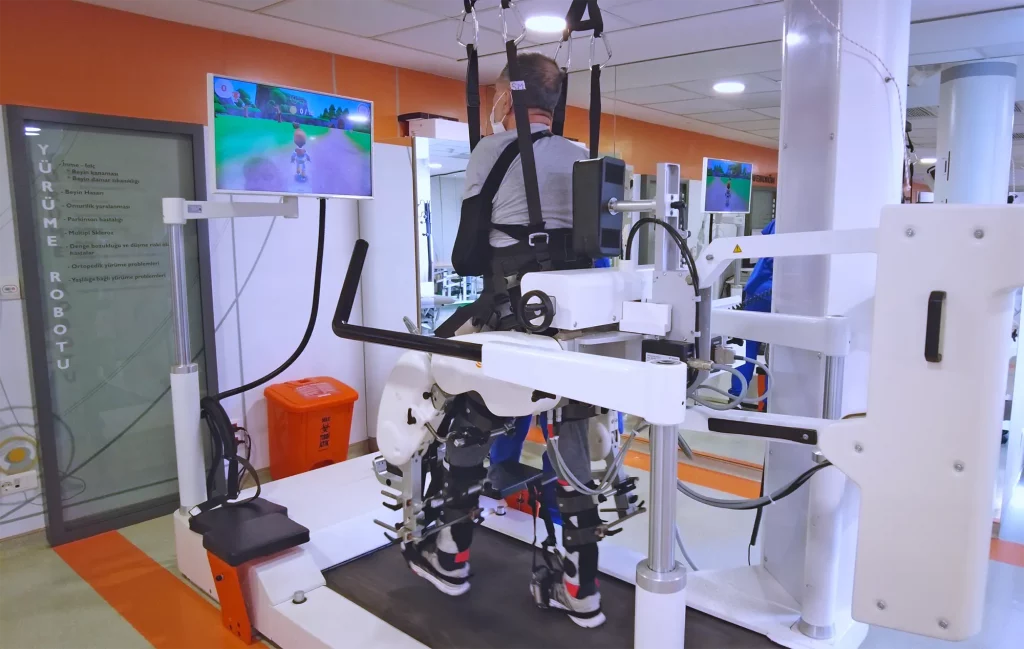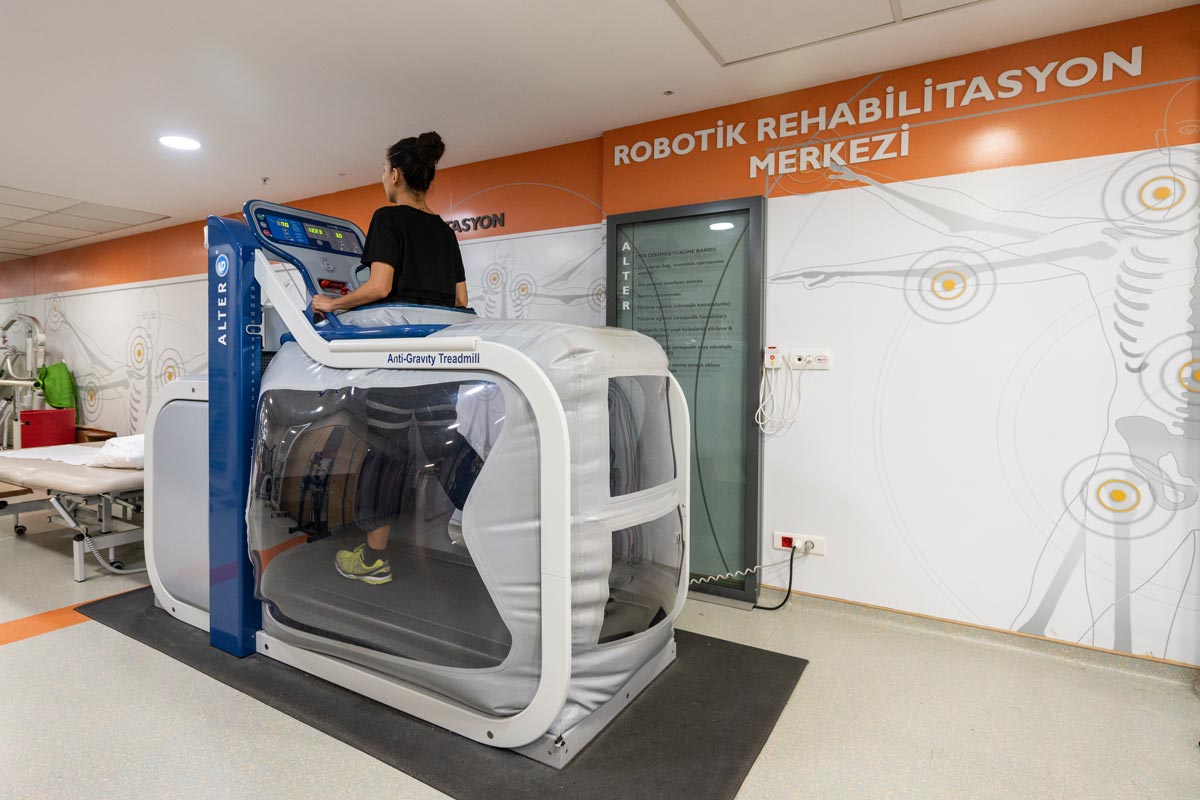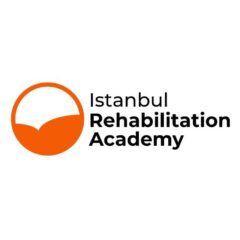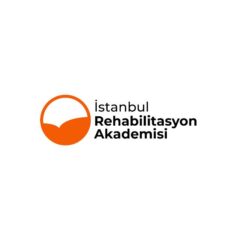1. Walking Rehabilitation
Walking disorder or not being able to walk is common situation in the patients of brain hemorrhage, brain embolism, embolic stroke, in the rehabilitation of brain injury and the period after brain tumor operation.
There may also be many resons of walking disorders like sedentary living style caused by ageing, Alzherimners, knee-hip prosthesis, Parkinson disease, Multiple Sclerosis (MR), Transverse Myelitis or Polyneuropathies named as nerve end inflammation.

In this case, enabling the atient to walk again can become one of the most important targets of physical therapy. In the robotic walking systems, the robotic apparatus and receivers placed on the waist, hip and knees of the ğatient evaluate the response given by the body for the movement and conveys to the computer on which stage of the wlaking there is a problem. When the patient breaches the normal walking, the robot can adjust the wlaking automoatically.
2. Robotic Gait Systems
The robotic walking systems can be summed up under 2 main titles as Early Period Passive Wlaking Robot- Robotic Bed and advanced period Active Assisted Walking Robot. Hocoma is the leader of the firms within this sector.
Lokomat Pro with Free D is the most advanced gait robot which is the most similar to the physiologic wlaking. POmn the other hand, Erigo Pro is one of the rare systems in its sphere as a robotic bed-robotically supported upright posture and walking system. Alter G, which is another robotic device used at our walkin laboratory, is an anti gravity walking system. It enables the training of the weak mussle goruop in a suşitable gravity level by reducing the gravity up to 80%. Because it diminishes the effect of gravit, it is named as “spacewalk” or “moonwalk”.
2.1. Gait Robot- Lokomat Pro with Free D

The Swiss firm Hocoma is a leader in the sphere of gait robots. They execute the most developed robotic therapy systems in this area. Lokomat Pro with Free D is the most advanced gait robot with the most remarkable similarity of normal walking physiology. The Free D feature is added to develop the most physiological walking while oscillating normally without any difficulty in the pelvic area.
With the dynamic body weight support and the robotic outer structure which is adjusted for each person, the most serious neurological cases can be brought to feet and the movements which resemble normal walking can be done. The pressure is reflected on the plantar area naturally, the ankle-knee-hip alignment is protected as suitable to normal condition. The hip and knee joint mobility angles can be adjusted tor the specific needs of the patients by the therapist. The sensors on the device record all the implemented movements. The movement which could not be done by patient is completed by the robot and in this way, the re-learning mechanism between brain and legs are stimulated.
There is also a virtual reality integration system in Lokomat Pro walking robot. In this system, the patients have a screen in front of them and an avatar which is the reflection of their body appears on this screen. There are many games fictionalized to increase the motivation of the patients. In this way, the patients find themselves in a bush walk or a gamified activity, so they regain their walking ability without feeling bored. During this process, graphics are revealed to the patients to show which joint and muscle groups are worked in what amount and their progress is monitored and recorded in this way.
2.2. Robotic Bed System - Erigo Pro

It is important to straighten the patients in the early period in case of the diseases like stroke, brain injury and brain tumor.
Many multiple problems like the impairment of consciousness, speech, understanding, nutrition, urinary and fecal incontinence, tracheostomy, urinary catheter, hearth rhythm problems, low and high blood pressure issues may be experienced especially in the earlier periods and these should be managed quite well.
Lying in the bed for a couple of weeks may cause the weakening of cardiovascular system, myolysis, osteolysis, eburnation, bed sores, decrease of intestinal activities and rise of depression risk in the patients with stroke. In order not to encounter these problems, the patient should be made afoot and moved as soon as possible. The robotic bed Erigo is developed to overcome the difficulties experienced in the conventional physical therapy methods of Tilt Table and Manual Joint motion exercises.
Erigo Pro Robotic Bed enables the patient to be straightened controllably and walked passively with robotic equipments in this early period while ensuring the control of all the medical problems via follow-ups. This enabling of early passive walking creates an opportunity to prevent the problems like advanced cardiovascular issues or joint rigidity which may occur because of being confined to bed. It also enables the patients to increase their environmental awareness and catalyses the eagerness to socialize.
There is also a muscle stimulation system with electric simulation to prevent myolysis in legs caused by immobility. The system can also be used to enable a rapid muscle development for the patients with advanced level myolysis.
2.3 Anti-Gravity Treadmill Alter G for Rehab & Training

Anti-Gravity Treadmill Alter G is a device which uses the differential air pressure developed initially for the training of NASA astronauts. With Alter G, the body weight of patients can be reduced up to 80 % in comparison to gravity, the wellbeing and performance can be enhanced. The gravity which affects the body is diminished with the positive air pressure. It also provides a fall-safe environment; the patients get rid of the fear of falling and focus themselves to walking. The muscle strength of the patient is strengthened while the self-confidence increases.
Anti-Gravity Treadmill system facilitates walking by providing a gravity-free environment for the patients who can walk with partial support by the help of active walking robot Lokomat after the level of early walking robot Erigo Pro in case of the patients who experience walking problems after brain hemorrhage, brain embolism, thrombosis, stroke, traumatic brain injury and brain tumor operations. Meanwhile, the correct walking abilities of the patients can be enhanced and the general strength can be increased under the guidance of a physiotherapist. While the walking is advanced, cardio-pulmonary performance of the patients is also increased.
Anti-Gravity Treadmill system can be also used in cases of pain caused by orthopedic injuries or operations, partial spinal cord damage, Parkinson’s disease, Multiple sclerosis (MS), Transverse Myelitis, diseases which affect many muscle and neural systems like Polyneuropathy, and in case of the walking abilities caused by the chronic diseases like obesity, general muscle and skeletal weakness caused by aging, and balance disorders.
3. Disadvantages of the Conventional Rehabilitation Methods
The physical therapy methods which had been applied until 90’s to make the people who lost their walking ability due to neurological reasons are mainly based on human strength. So, the therapist needs to support the patient with their muscle power to make the patients who cannot stand upright and carry their weight to stand upright and make the walking exercises in order both to ensure the balance and support the body weight. Besides, the devices named orthosis are also benefited to stabilize the joints like ankle, knee or hip. With the passive support of orthosis and the active assistance of the physiotherapist, the exercises are made to regain the balance and walking abilities of the patients who have serious neurological damage. The walking exercises may be applied on the parallel bar or treadmill. This method is the physical therapy method which has been applied commonly until now and called as “conventional”.
On the other hand, the conventional methods of physical therapy and rehabilitation which aims to make the patients of serious neurological cases regain the normal functions. We can classify them as:
- The physiotherapists get exhausted physically.
- More than one therapist may be needed to keep the patient afoot.
- The sessions and intensity of the therapy are limited because of the necessity to have human power.
- The objective feedback opportunities regarding the patient performance are limited.
- The exercises may not be repeated in the same accurateness and safety during the session. The movements which are compatible with the walking physiology may not be applied accurately in the each session.
For these reasons, the robotic therapy technologies have been developed for the area of physical therapy and rehabilitation to contribute the applications of the physiotherapist and ergotherapists, and increase the effectiveness of the therapy.
4. Robotic Walking Devices Enhance the Efficiency of Therapy!
Thanks to the robotic walking devices, the difficulties encountered during the conventional walking rehabilitation can be overcome easily. In walking with robotic physical therapy, because the lifting systems of the device carries the body weight of the patient and execute the joint mobility in control, the necessity for manpower is eliminated for the therapist.
The walking exercises can be applied intensely and in safety since the early periods of the disease by the frequent repetition of the walking exercises with the robotic therapy systems like Hocoma Erigo Pro Robotic Bed, System, Lokomat Pro with Free and Alter G Anti-Gravity treadmill. The physical therapy which is applied with robotic devices in the early period in case of brain tumor operation, brain injury or stroke is a quite effective method to prevent permanent paralysis by helping the rapid healing process and stimulating the brain plasticity.
There are further benefits of robotic therapy in physical therapy and rehabilitation regarding the regaining of the walking ability in the earlier period. Among these benefits, strengthening of the muscles of the bedbound patients, ensuring the blood circulation in legs, reducing the risk of osteolysis and fracture risk, preventing the risk of bed sores and the vain inflammation and blockages named as Deep Vein Thrombosis (DVT) can be counted.


